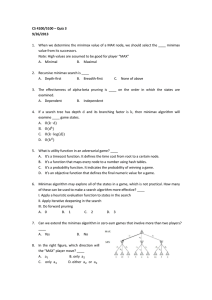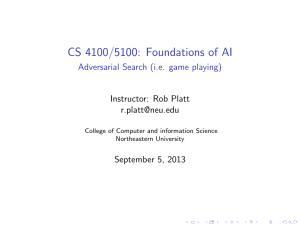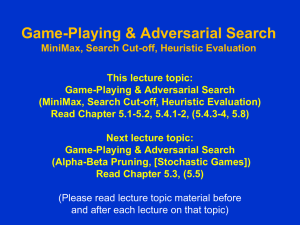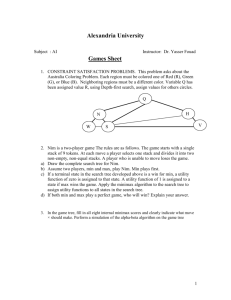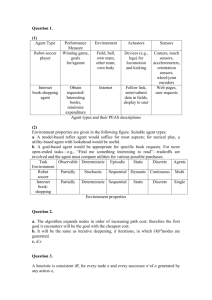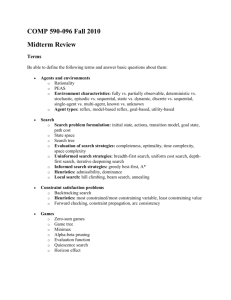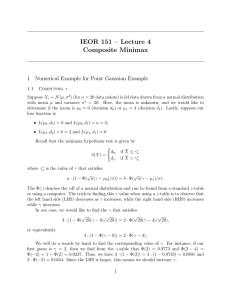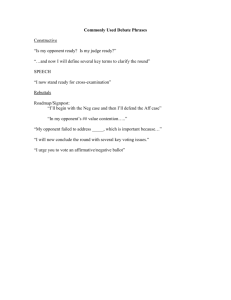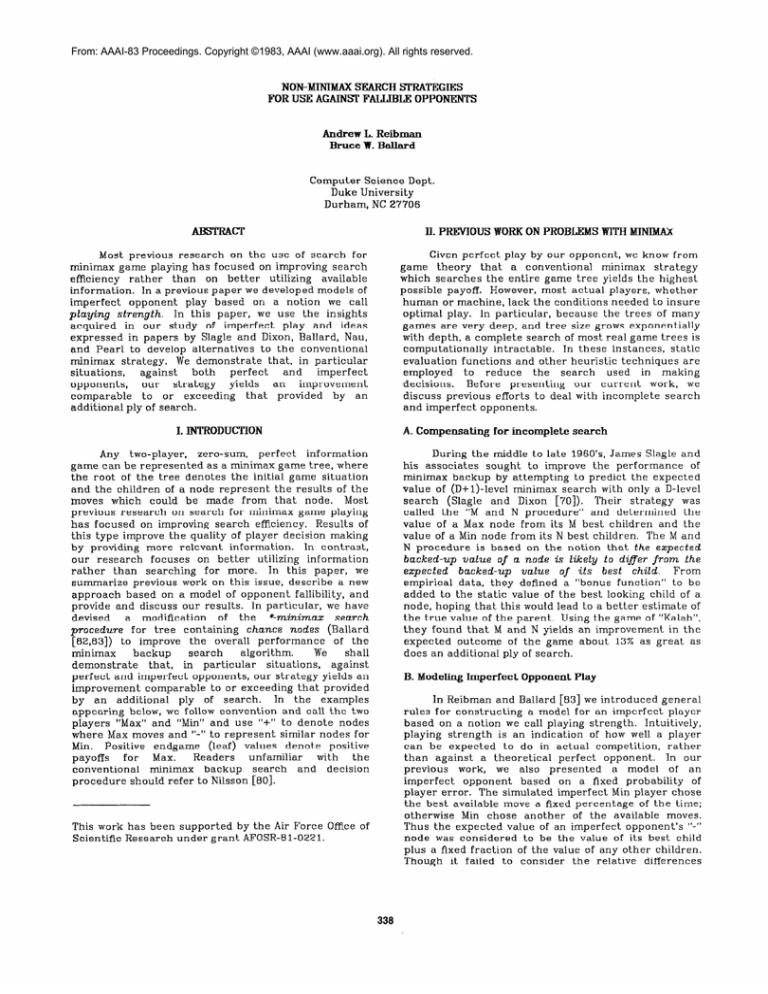
From: AAAI-83 Proceedings. Copyright ©1983, AAAI (www.aaai.org). All rights reserved.
NON-MINTMAX SEARCH SI’RAmGIES
FOR USE AGAINST FALLIBIX OPPOmS
Andrew I,. Reibman
Bruce W. BaIlard
Computer Science Dept.
Duke University
Durham, NC 27706
ABSTRACT
II. PREVIOUS WORK ON PROBLEMS WITH MINIMAX
Most previous research
on the use of search for
minimax game playing has focused on improving search
efficiency
rather
than on better
utilizing
available
information.
In a previous paper we developed models of
imperfect
opponent
play based on a notion
we call
playing strength.
In this paper, we use the insights
acquired
in our study of imperfect
play and ideas
expressed
in papers by Slagle and Dixon, Ballard, Nau,
and Pearl to develop alternatives
to the conventional
minimax strategy.
We demonstrate
that, in particular
perfect
against
both
and
imperfect
situations,
strategy
yields
an
improvement
opponents,
our
comparable
to or exceeding
that
provided
by an
additional ply of search.
Given perfect play by our opponent, we know from
game
theory
that a conventional
minimax
strategy
which searches the entire game tree yields the highest
possible payoff.
However, most actual players, whether
human or machine, lack the conditions needed to insure
optimal play. In particular,
because the trees of many
games are very deep, and tree size grows exponentially
with depth, a complete search of most real game trees is
computationally
intractable.
In these instances,
static
evaluation functions and other heuristic techniques
are
employed
to
reduce
the
search
used
in making
decisions.
our current
work, we
Before
presenting
discuss previous efforts to deal with incomplete
search
and imperfect
opponents.
I. INTRODUCTION
A. Compensating
During the middle to late 1960’s, James Slagle and
his associates
sought to improve the performance
of
minimax backup by attempting
to predict the expected
value of (D+l)-level
minimax search with only a D-level
search
(Slagle
and Dixon [70]).
Their strategy
was
called the “M and N procedure”
and determined
the
value of a Max node from its M best children and the
value of a Min node from its N best children.
The M and
N procedure
is based on the notion that the expected
backed-up value of a node is likely to difler from the
expected
backed-up
value
of its best child.
From
empirical
data, they defined a “bonus function”
to be
added to the static value of the best looking child of a
node, hoping that this would lead to a better estimate of
the true value of the parent. Using the game of “Kalah”,
they found that M and N yields an improvement
in the
expected
outcome
of the game about 13% as great as
does an additional ply of search.
Any two-player,
zero-sum,
perfect
information
game can be represented
as a minimax game tree, where
the root of the tree denotes the initial game situation
and the children of a node represent
the results of the
Most
moves which could be made from that node.
previous research
on search for minimax game playing
has focused on improving search efficiency.
Results of
this type improve the quality of player decision making
by providing
more relevant
information.
In contrast,
our research
focuses
on better
utilizing
information
rather
than searching
for more.
In this paper, we
summarize previous work on this issue, describe a new
approach based on a model of opponent fallibility,
and
provide and discuss our results. In particular,
we have
*-minimax
search
devised
a modification
of
the
procedure
for tree containing
chance nodes (Ballard
the overall
performance
of the
[82,83])
to improve
algorithm.
We
search
shall
minimax
backup
demonstrate
that,
in particular
situations,
against
perfect and imperfect
opponents, our strategy yields an
improvement
comparable
to or exceeding
that provided
by an additional
ply of search.
In the examples
appearing below, we follow convention
and call the two
players “Max” and “Min” and use “+‘I to denote nodes
similar nodes for
where Max moves and “-” to represent
endgame
(leaf)
values
denote
positive
Min. Positive
Readers
unfamiliar
with
the
for
Max.
payoffs
conventional
minimax
backup
search
and decision
procedure
should refer to Nilsson [60].
This work has been supported by the Air Force
Scientific Research under grant AFOSR-81-0221.
for incomplete search
B. Modeling Imperfect
Opponent Play
In Reibman and Ballard [83] we introduced
general
rules for constructing
a model for an imperfect
player
based on a notion we call playing strength.
Intuitively,
playing strength
is an indication
of how well a player
can be expected
to do in actual competition,
rather
than against a theoretical
perfect
opponent.
In our
previous
work,
we also presented
a model
of an
imperfect
opponent
based on a fixed probability
of
player error. The simulated imperfect Min player chose
the best available move a fixed percentage
of the time;
otherwise
Min chose another
of the available
moves.
Thus the expected
value of an imperfect
opponent’s
“-”
node was considered
to be the value of its best child
plus a fixed fraction of the value of any other children.
Though
it failed to consider
the relative
differences
Office of
338
between
the values of moves, this simple model was
found
to be better
for
use in our
study
than
conventional
minimax.
The reader
may have noticed
in the preceding
section a resemblance
between
the notion of a bonus
function
and our attempt
to accurately
predict
the
expected value of moves made by a fallible opponent.
In
Ballard and Reibman [83b], we prove that in a simplified
form
of the model we present
below, with a fixed
probability
of opponent
error,
our strategy
can be
obtained by an appropriate
form of M and N (and vice
although
the exact
backed
up values being
versa),
determined
will differ. This is because Slagle and Dixon’s
bonus function
was approximately
linear, while ours,
based on the arc-sum tree model we use below, is a 4-th
degree polynomial.
-HI.THE UNRESOLVED PROBLEM OF OPPONENT FALLIBILITY
In addition
to having an inability to completely
search
actual game trees, actual implementations
of
minimax
assume
perfect
play
by
their
opponent.
However, this assumption
often is overly conservative
and can be detrimental
to good play. We now present
two general
classes
of situations
where
minimax’s
perfect opponent assumption leads to sub-optimal play.
A. Forced Losses and Breakhg
Ties
The first problem with minimax that we consider is
its inability to “break ties” between nodes which, though
they have the same backed-up
value, actually
have
different expected results. A readily observable example
of this problem is found in forced loss situations.
In the
two-valued game in Figure 1, Max is faced with a forced
loss. Regardless of the move Max makes at the ‘I+” node,
if Min plays correctly Max will always lose. Following the
minimax
strategy,
Max
would
play
conventional
randomly, picking either subtree with equal frequency.
Suppose, however, that there is a nonzero
probability
that Min will play incorrectly.
For illustration,
assume
Min makes an incorrect
move 10% of the time. Then if
Max moves randomly, the expected outcome of the game
is .5(O) + .5(.9+0 + .l*l)
= .05. If Max knows that, on
occasion, Min will move incorrectly,
this knowledge
can
be used to improve the expected
payoff from the game.
Specifically,
Max can regard each “-I’ node as a “chance
node” similar to those that represent
chance
events
(Ballard
such as dice rolls in non-minimax
games.
[82,83] gives algorithms
suited to this broader class of
“*-minimax”
games.)
Thus
Max
evaluates
“-” by
computing
a weighted average of its children, based on
their conjectured
probabilities
of being chosen by Min,
rather than by finding just the minimum. Following this
strategy, Max converts the pure minimax tree of Figure
1 into the *-minimax tree also shown, and determines
the values of the children of the root as 0 and 0.1. The
rightmost branch of the game tree is selected because it
In terms
of
now has the higher
backed-up
value.
expected
payoff, (which is computed as O*(O) + 1.0*(.9*0
+ .1*1) = O.l), this is clearly
an improvement
over
standard minimax play. Furthermore,
this strategy is an
improvement
over minimax
in forced
loss situations
regardless of the particular probability
that Min will err.
+
tmkql /+\
lzakup
value=0 /
\ MlUe=c
/\
00
/\
10
txxhp
/
value=0 /
+
p=.5 / \ F.5
00
\
hackup
\ value=.1
+
p=.l / \ p=.9
10
Figure 1 : In an attempt to salvage a forced loss situation
the minimax tree on the left is converted to the +-minimax
tree on the right.
loss
Our
observed
in
forced
improvement
situations is a specific example of “tie-breaking”,
where
the equal grandchild values happen to be zero. Because
minimax
uses
only
information
provided
by
the
positions
with
extreme-valued
children
of a node,
different
expected
results often appear equivalent
to
Variant
can
thus
improve
strategies
minimax.
performance
by breaking ties with information
minimax
obtains but does not use.
B. Exploiting Our Opponent’s Potential For Error
By always assuming
its opponent
is a minimax
player, minimax misses another class of opportunities
to
its
although
less
improve
expected
performance,
obvious than the forced loss situation presented
above.
An example is found in Figure 2. Assume as above that
Min makes the correct move with probability
.9. If Max
uses the conventional
backup strategy and chooses the
left node, the expected
outcome of the game is 2.1. If,
however,
we recognize
our opponent’s
fallibility
and
convert the Min nodes to “*‘s”, (as in Figure 2), we must
choose the right branch and the game’s expected
result
increases
to 2.9. Thus by altering the way we back up
values to our opponent’s
nodes in the game tree, we can
improve our expected performance
against an imperfect
opponent.
+
baclaq,
/
valuec2.1 /
*
backup /+\
b=m
\ val-afF1
vallE& 1
/\
If.
1 20
23
Figure
2 : By converting
jF.S/\p=.l
1
p=.9/\p=.l
23
the
minimax
backup
\ valuE+Z.9
+
120
tree
on
the left
to
the *-minimax tree on the right we may capitalize on our
opponents potential for error.
In the example of a forced loss, the improvement
in performance
was due to the ability of a weighted
average
backup scheme
to correctly
choose between
moves which appear equal to conventional
minimax.
In
the second
example,
our variant
backup
yielded
a
“radical
difference”
from minimax, a choice
of move
which
differed
not
because
of “tie-breaking”,
but
because
differing
backup strategies
produced
distinct
choices of which available move is correct.
IV. A NEW MODEL FOR IMPERFECT PLAY
an opportunity
to profit
by
Having
observed
exploiting errors which might be made by our opponent,
we have formulated
a more sophisticated
model of an
imperfect
opponent than was previously considered.
We
will first provide the motivation
for our enhancements
and then describe
the details of the imperfect
player
model used in the remainder of the paper.
A. Motivation for a Noise-based
Model
In general, it should be fairly easy to differentiate
between moves whose values differ greatly.
However, if
two moves have approximately
the same value, it could
be a more difficult task to choose between them. The
strength of a player is, in part, his ability to choose the
Playing
correct
move from a range
of alternatives.
strength
can therefore
correspond
to a “range
of
the ability of a player to determine
the
discernment”,
An inability
to distinguish
relative
quality of moves.
between
moves
with
radically
different
expected
could
have
drastic
consequences,
while
outcomes
similar difficulties with moves of almost equal expected
have less effect
on a
payoff should, on the average,
player’s overall performance.
We model players of various strengths
by adding
noise to the information
they use for decision making. A
move evaluation
is a perfect
player
with noiseless
opponent, while a player with an infinite amount of noise
plays
randomly,
We
evaluation
injected
into
its
introduce
noise at the top of an imperfect
player’s
search tree in an amount inversely proportional
to the
player’s strength.
B. The Noise-based
Model in Detail
We now describe
the details
of our imperfect
Each imperfect
Min player is assigned a
player model.
the
actual
games,
Tn simulating
playing
strength.
imperfect
Min player conducts a conventional
minimax
backup search to approximate
the actual value of each
child of the current position.
The backed-up values of
each child are then normalized
with respect
to the
of possible
backed-up
values
and a random
range
number, chosen from the uniform distribution
0 <= x <=
S, (where S is inversely related to the player’s strength),
is added to the normalized value of each child. Thus the
lower
a player’s
strength
the higher
the average
magnitude of the noise generated.
The true node value
with noise added is then treated
as a conventional
backed-up
value.
We add the noise to the top of a
player‘s search tree because the actual effect of adding
noise to the top of the tree can be studied analytically
while the effect of introducing
noise in the leaves is less
well understood
(Nau [f30,82]). As described in Reibman
and Ballard [83], we have verified
that, in our noisebased model, decision quality degrades monotonically
with respect to increases in the magnitude of the noise
added to the conventional
backed-up value.
V. A STRATEGY FOR USE AGAINST IMPERFECT OPPONENTS
We now present
a strategy
for
use against
We have based this strategy
on
imperfect
opponents.
the *-minimax
search algorithms
for trees containing
in
order
to
compensate
for
the
chance
nodes
probabilistic
behavior of fallible opponent.
Three main
assumptions
are used as a foundation:
(1) Against a Mm
player
assumed
to be perfect,
we should
use a
conventional
Max strategy.
(2) Against an opponent who
plays randomly, we should evaluate ‘I-” nodes by taking
an unweighted
average of the values of their children.
(3) In general,
against imperfect
players,
we should
evaluate I’-” nodes by taking a weighted average of the
values
of their
children,
deriving
the
appropriate
probabilities
for
computing
this
average
from
an
estimate of our opponents playing strength.
In an attempt
to predict
the moves
of our
imperfect
opponent, we assign our opponent a predicted
strength, denoted PS, between
0 and 1. To determine
the value of I’-” nodes directly
below the root, our
predictive
strategy searches and backs up values to the
@‘+‘@ nodes
directly
below
each
I’-” node
using
conventional
minimax. A “-I’ node with branching factor
Br is then evaluated
by first sorting the values of its
children
in increasing
order, then taking a weighted
average
using
probabilities
PS,
(l-Ps)*Ps,...,(
lPS)**(Br-1)
* PS.
If PS=l,
we consider
only the
minimum-valued
child of a ‘I-” node, in effect predicting
that our opponent is perfect.
At the other extreme,
as
PS approaches
0, a random opponent
is predicted
and,
since the probabilities
used to compute
the weighted
average become equal, the Min node is evaluated by an
unweighted
average of its children.
How well our model
predicts the moves of an imperfect
opponent should be
reflected
in our strategy’s
actual performance
against
such a player.
Vi. AN EIWIRKXL
ANALYSIS OF THE PREDICTIVE fjTRATEGY
In Reibman
and Ballard
[83] we conducted
an
empirical analysis to investigate the correlation
between
playing
strength
as
defined
in
our
model
and
performance
in actual competition.
We now conduct an
empirical
study to compare
the performance
of our
predictive
algorithm with that of conventional
rninimax
backup.
We conduct
our trials with complete
n-ary
game trees generated
as functions of three parameters:
D denotes the depth of the tree in ply, Br the branching
In
factor,
and V, the maximum allowable “arc value”.
our study we assign values to the leaves of the game
tree by growing the
et at [73]).
Every
assigned
a random
distribution
between
then the sum of arcs
tree in a top-down fashion (Puller,
arc in the tree is independently
integer
chosen from the uniform
0 and V. The value of each leaf is
leading to it from the root.
The portion of our study presented
here consists
of several identical
sets of 5000 randomly
generated
game trees with Br=4, D=5, and V=lO. Against seven 2ply Min opponents, ranging from pure minimax to almost
minimax
players
random
play, we pit conventional
searching
l-, 2-, and 3-ply, and 10 predictive
players,
each with a 2-ply search and a PS chosen from between
.1 and .9. The results of this experiment
are found in
Table 1. Before summarizing
our observations,
we note
that the numbers
in Table 1 represent
points on a
continuum;
they indicate
general
trends but do not
convey the entire spectrum of values which lie between
the points we have considered.
In the first column of Table 1, we observe that,
though
it might be expected
that pure Max backup
would be the optimum
strategy
against conventional
players perform
bett-2r
Edin, several of our predictive
Table 1
Empirical Study Results
Trials=5000, Br=4, D=5, Game Values O-50
Average
Max’s Strategy
l-ply
0.00
minimax
27.23
2-ply minimax
20.15
28.98
3-ply minimax
2-ply PS = 0.9
Z-ply PS = 0.8
Z-ply PS = 0.7
payoff
over all games
Imperfect
0.25
0.50
Player
Noise Range
0.75
1.00
2.00
6.00
33.13
33.62
34.14
33.90
34.47
34.58
34.76
34.31
34.65
35.01
34.9 1
34.92
30.60
31.29
32.34
32.90
32.05
33.36
33.46
33.96
28.2 1
28.2 1
31.40
31.40
33.03
33.62
34.03
34.58
33.62
33.62
34.03
34.04
34.58
34.58
28.21
31.40
33.03
33.02
28.2 1
28.20
31.40
31.41
33.02
33.05
33.62
33.66
34.05
34.10
34.60
34.66
34.95
35.00
2-ply PS = 0.4
28.20
28.17
28.13
31.42
31.41
33.10
33.11
33.70
33.75
34.15
2-ply PS = 0.3
2-ply PS = 0.2
34.72
34.99
35.07
35.12
33.13
33.77
2-ply PS = 0.1
28.08
31.40
31.39
34.19
34.22
33.14
33.79
34.24
2-ply PS = 0.6
2-ply PS = 0.5
than a conventional
Max player
searching
the same
number of ply. The observed improuement is as much as
7% of the gain we would expect from
adding an
to the conventional
Max
additional ply
of search
strategy.
This result is analogous to that obtained with
Slagle and Dixon’s M and N strategy.
Like M and N, our
improvement
is due, at least in part, to a strategy which,
by considering
information
from more than one child of
a node, partially compensates
for a search which fails to
reach the leaves.
In the central
columns of Table 1, we see that
against
an opponent
whose
play is imperfect,
our
can
provide
almost
half
the
expected
strategy
improvement
given by adding an additional ply of
search to the conventional
Max strategy.
We believe this
gain is due primarily
to the ability of our strategy
to
capitalize on our opponent’s potential for errors.
If we examine the results in the last two columns
of Table 1, we observe that, against a random player, our
strategy yields an improvement up to twice that yielded
by an additional ply of search.
As the predicted
strength of our opponent goes down, our predictions
of
our opponent’s
moves become more a simple average of
the
alternatives
available
to him than
a minimax
backup.
We have previously
conjectured
that the most
accurate
prediction
of the results of random play is
and,
as expected,
such
a weighted
average
our
performance
continues
to
improve
strategy’s
dramatically
as the predicted strength decreases.
drawback
to the
We also observe
a possible
indiscriminate
use of our strategy.
When we begin to
overestimate
our opponents
fallibility, our performance
degrades.
In Column 1 of Table 1, our performance
peaks. If we inaccurately
overestimate
the weakness of
our opponent, our performance
declines and eventually
falls below that of minimax. We have observed
similar
declines
in other
columns
as we let the predicted
strength
move even closer
to 0 than the minimum
predicted
strengths shown in Table 1.
34.92
34.83
35.16
34.85
35.19
Having derived the results given above, we decided
to tabulate
the maximum
improvement
our strategy
achieves over minimax.
This summary is found in Table
2. We also give the results (in Table 2) of statistical
confidence
tests
we have applied
to our empirical
analysis.
These
tests
help
to assess whether
our
strategy
actually performed
better than minimax.
The
percentages
indicate
the level of confidence
that the
improvements
observed were not due to chance (given
the actual normal distribution
of our sample of trees).
We note that in all but the first two columns
our
confidence
levels are well over 90%.
VII. CONCLUSION
In this paper we have discussed the problem
of
adapting game playing strategies
to deal with imperfect
opponents.
We first observed
that, against a fallible
adversary,
the conventional
minimax backup strategy
does not always choose the move which yields the best
expected
payoff.
To investigate
ways of improving
rninimax, we formulated
a general model of an imperfect
adversary
using the concept
of “playing strength”.
We
then proposed
an alternative
game playing strategy
which capitalizes
on its opponents
potential
for error.
An empirical
study was conducted
to compare
the
performance
of our strategy with that of minimax. Even
against
perfect
opponents,
our strategy
showed
a
marginal improvement
over minimax and, in some other
cases, great increases in performance
were observed.
We have presented
some results of our efforts to
develop
variant
minimax
strategies
that
improve
performance
of game players in actual competition. Our
present and future research includes a continued effort
to expand
and generalize
our models
of play, our
predictive
strategy,
and the assessment
of opponents
iTsing a playing strength measure.
Further study of our
models
has included
not only additional
empirical
experiments
but also closed-form
analysis
of some
closely related game tree search problems.
We hope to
eventually
acquire a unified understanding
of several
Table 2
Statistical Analysis of Empirical Study
X
Predictive
play %
% improvement
over
2-ply minimax
(in % of l-ply)
Statistical Confidence:
Is our optimum expected
payoff better than that
of Z-ply minimax?
Imperfect
Player
Noise Range
0.25
0.50
0.75
1.00
2.00
7.2%
17.1%
52.1%
66.0%
82.9%
211.0%
58.2%
82.9%
98.2%
99.8%
99.8%
99.8%
0.00
distinct problems with minimax in order to develop a
more general game playing procedure
which retains the
strong points of minimax while correcting
its perceived
inadequacies.
[9] Pearl, J. On the Nature of Patholo,,
UCLA-ENG-CSL-82Technical
Report
and
Applied
Science,
Engineering
California, Los Angeles, Jan. 1982.
[I]
[lo]
Reibman, A. and B. Ballard.
Competition
Against
Region
ACM
Southeast
21st
Opponents,
Fallible
Conference, Durham, North Carolina, April 1983.
Ballard,
B.
A
Information
Games
Analysis. Proceedings
Search
Procedure
for
Perfect
of Chance:
Its Formulation
and
of AAAI-82, August 1982.
in Game Search.
School
of
17,
University
of
with the M & N
[ll]
Slagle, R. and J. Dixon. Experiments
of the ACM,
Communications
Tree-Searching
Program.
March 1970, 13 (3), 147-153 .
[Z] Ballard,
B. The *-Minimax
Search Procedure
for
Trees Containing
Chance Nodes. Artificial Intelligence,
to appear.
[3] Ballard,
B. and A. Reibman,
“What’s Wrong with
,Minimax?“. 1983 Conf. on Artificial Jdelligence, Oakland
University Rochester, Michigan, April, 1983.
[4] Ballard, B. and A. Reibman, “Experience
with NonMinimax Search Criteria for Minimax Trees”.
Technical
Report in preparation,
to be submitted for publication,
1983.
[5] Fuller, S., Gaschnig, J. and J. Gillogly. An analysis of
th alpha-beta
pruning
algorithm.
Dept. of Computer
Science Report, Carnegie-Mellon
University, July 1973.
[6] Nau, D. Quality of Decision Versus Depth of Search in
Game Trees:
A summary
of Results.
first
Annual
National Conference on Artificial Intelligence,
August
1980.
[7] Nau, D. Pathology
on Game Trees Revisited and an
Alternative
to Minimaxing.
Technical
Report, Dept. of
Computer Science, University of Maryland, Jan. 1982.
[8] Nilsson, N. Principles of Artificial EnteLLigence. Tioga,
Palo Alto, 1980.
342

